A huge flying boat "Airliner Number 4" planned as a regular flight across the Atlantic Ocean
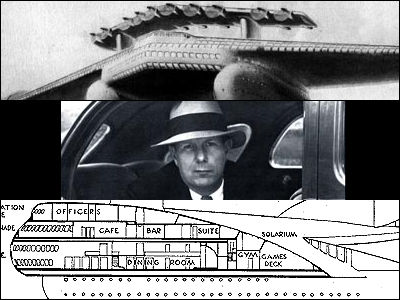
Norman Bell Geddes (Norman Bell Geddies) was a stage artist and industrial designer active in the first half of the 20th century and exhibited at the New York Expo in 1940FuturamaIt is famous for. He planned in 1929, the transatlantic regular flight "Airliner Number 4". It is a huge fuselage to say that it is a fantasy flying boat, and if it was realized it is definitely quite interesting.
Details about Airliner are as follows.
The hint of Airliner # 4 was that of Germany / DornierDo XIt is a flying boat.
Do X floating on the water surface.
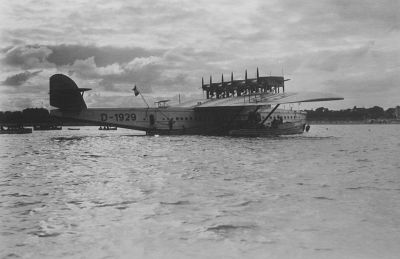
The flying boats
In the 1920s, as the ship or airship was transporting passengers across the Atlantic Ocean, three planes were planned as the world's largest aircraft Do X at the time, three were manufactured. Demo flights were done, but there were a lot of problems, so we did not receive orders from airlines. Given this Do X, Geddes confirmed that "big thing" is key to safety and comfort, designed Airliner # 4 with the help of Dr. O.A. Koller.
The power of Airliner # 4.

Cross-sectional view seen from the side. Float is too big.
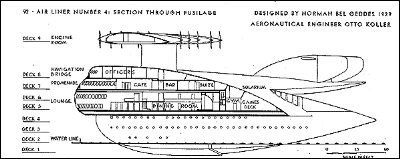
Floor plan of the deck. This is a floor with a lounge and main dining.
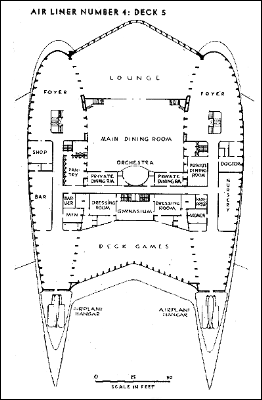
There is a machine room (repair work is possible) inside the auxiliary wing, and six substitute engines are carried. It seems that something like a small railroad was laid and allowed to freely move inside the auxiliary wing and it was possible to replace the engine even during flight. Engine which became useless will be replaced with spare in 5 minutes, it will be carried to machine room and will be repaired. There are 20 engines in total, but this is the number needed for takeoff, and it seems that 12 were enough if only to fly at the cruising speed. Inside the aircraft, there were sixteen 40-foot (approximately 12 m) class lifeboats with capacity of 110 people, the lifeboat was loaded with engines, side windows, wireless communication machines, two weeks of water and food. In addition, two floating wing type small aquatic aircraft are mounted on the float of the aircraft. This plane was able to take off in the air and water, and it came to be asked for help as soon as it was time to come.
Initially, I thought that Chicago businessman used Airliner # 4 to connect between Chicago and London via the St. Lawrence River and the Great Circle. As a result of elaborate research and calculation, I understood that this plan is also likely to be commercially available. The flight time between Chicago and London is 42 hours, refueling when passing through Newfoundland island. It is possible to operate three flights per week, only one week per week on the Atlantic routesOcean linerThere was a big advantage compared to.
Airliner # 4 costs $ 9 million (at the time of the 1930s, about a hundred million dollars = about 117 if it is a modern day value, while the construction of a ship used for modern ocean liners costs nearly $ 70 million) About 100 million yen). It was thought that round trip operation can be done according to schedule if 6 aircraft were built. The fare is about 300 dollars as much as the first fare of the ship (about 3,500 dollars in the present age = about 410 thousand yen). Moreover, the facilities were as wide and comfortable as the modern Ocean liners.
According to the prospects, if you operate for a week, the revenue from fare, postal fee, baggage etc is $ 470 900. The cost was estimated to be 273,950 dollars including personnel expenses, fuel and maintenance expenses, overhead expenses, depreciation of airplanes, and the profit per week would be $ 196,950. Simply modifying it to modern amount amounts to 2,240,395 dollars, Japanese yen will be about 270 million yen. I wonder if it was really possible ....
By the way, as you can see from the fact that this flying boat does not appear in the subsequent history, the plan seems to have become useless, and the air route crossing the Atlantic Ocean is born due to Pan American Airlines on June 28, 1939 We have to wait for the air route to be opened. The Chicago businessman who promoted this plan seems to have not given up the plan for a while and leaves the following words in his book. "If we can make inter-continental freight flights, Chicago can be easy to become the world's metropolis like New York, because of that influence."
Designed Norman Bell Geddes died in 1958.
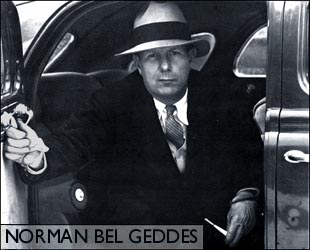
The original article is below.
BelGeddes
Related Posts:
in Ride, Posted by logc_nt







